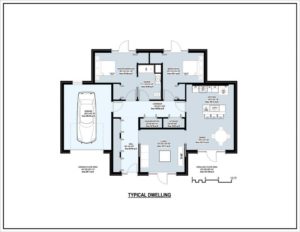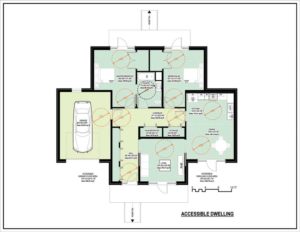Design fundamentals of accessible and adaptable dwelling units

Areas of study
A study in the following areas is required to determine the supply and demand of accessible units without using excessive national resources. Here are factors to consider:
- The supply and demand for accessible and adaptable housing in Canada.
- What should be the percentage of accessible dwelling units in a new development?
- What should be the minimum percentage of adaptable dwelling units; should all the accessible units be designed and constructed to be adaptable units or only a percentage of it?
- Accessible dwelling units need wider doors, hallways/public corridors, bigger kitchens, washrooms, bathing areas, etc. Therefore, a detailed study must examine the useable and public space ratio change from conventional dwelling units.
- What is the impact on the cost of an accessible and an adaptable dwelling unit converted into an accessible dwelling unit compared to a standard dwelling unit?
- Should the design of accessible and adaptable units be included in Section 3.8. of National Building Code (NBC) or as a supplementary guide or standard?
Rationale for the study items
The first three factors
The first three factors are interrelated; therefore, a study on these items will help estimate the correct and expected increase in the next 20 years. The benefit of a survey is to strike an efficacious balance between the supply and demand for accessible housing in Canada. Suppose all or most dwelling units in a new housing development are designed and constructed as flexible-accessible units (i.e. convertible into adaptable dwelling units). In this case, the housing units may only be occupied if the availability is within the demand, burdening national resources.
A housing complex occupied by mostly accessible populations may lead to evacuation concerns
(e.g. overcrowding). Further, it is a known fact the time taken to evacuate a building by a person using a mobility device is higher than the average able-bodied person. For example, a person in a wheelchair could propel at a speed of 0.54 m/s (1.77 ft/s) compared to 1.19 m/s (3.90 ft/s) for an average able-bodied healthy person. Therefore, does it mean the code’s travel distance requirements should be revisited to combat the additional time needed by occupants who are disabled to evacuate the building safely or additional fire protection and life safety features are included for accessible dwelling units?
The above two scenarios explain the necessity of having a comprehensive study holistically determining the populations who require MURBs. Once an adequately reliable number of such populations is available, the percentage of accessible and adaptable dwelling units could be judiciously included in the model code.

Figures 1 and Figure 2 explain an increase of 11 per cent in a floor area when a moderate size dwelling unit with a single bathroom is designed as an accessible dwelling unit. The floor area increases to 13 per cent if there are two bathrooms provided in it.
The other factors
Factors four and five complement each other. For example, it is evident from the details of the items listed previously that wider doors, accessible windows, bigger kitchens, washrooms, and other accessible needs will cost more than conventional dwelling units. Likewise, an additional cost for the rough-in for grab bars, tracks, rails, and ceiling hoists for later installation is required. A cost comparison impact should be a part of the research to optimize the accessibility requirements.







